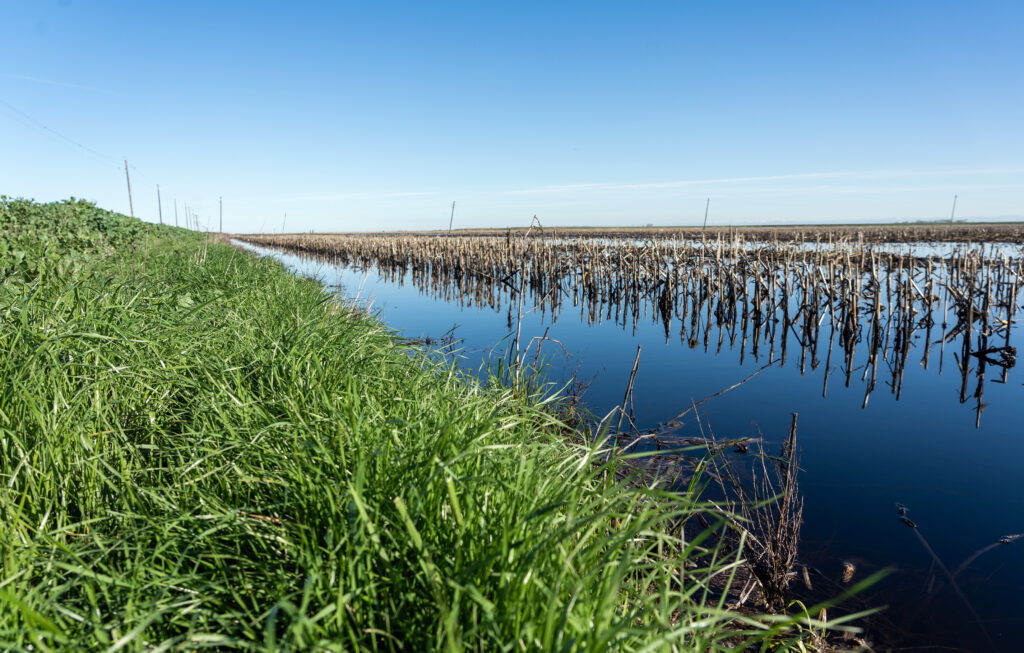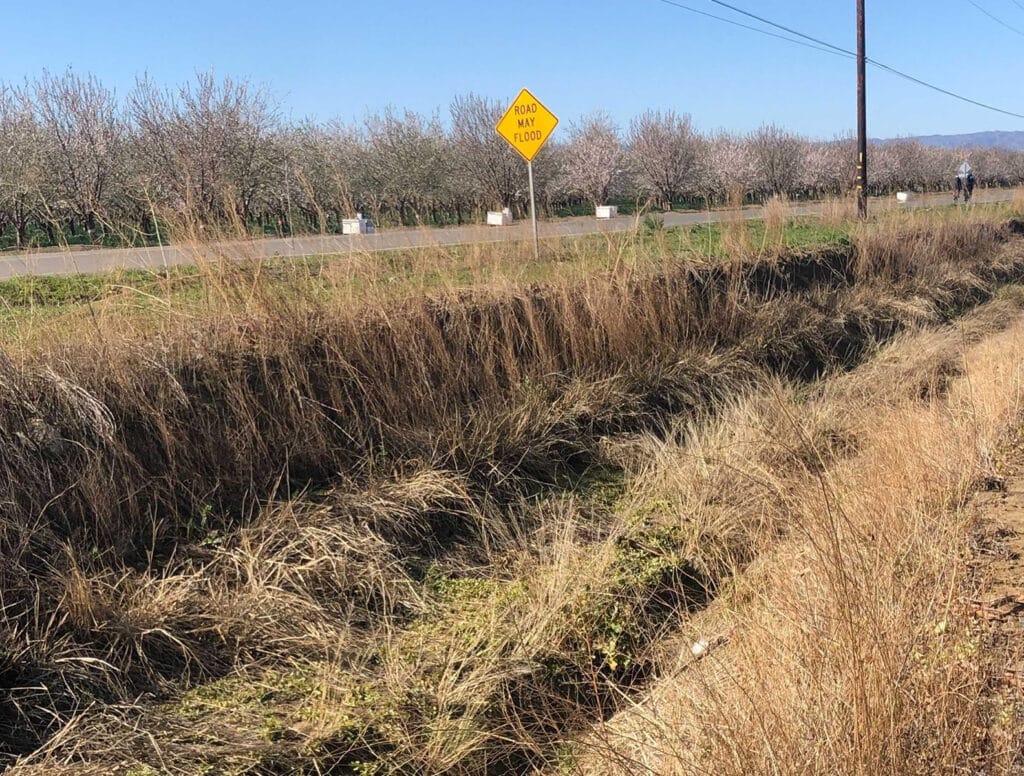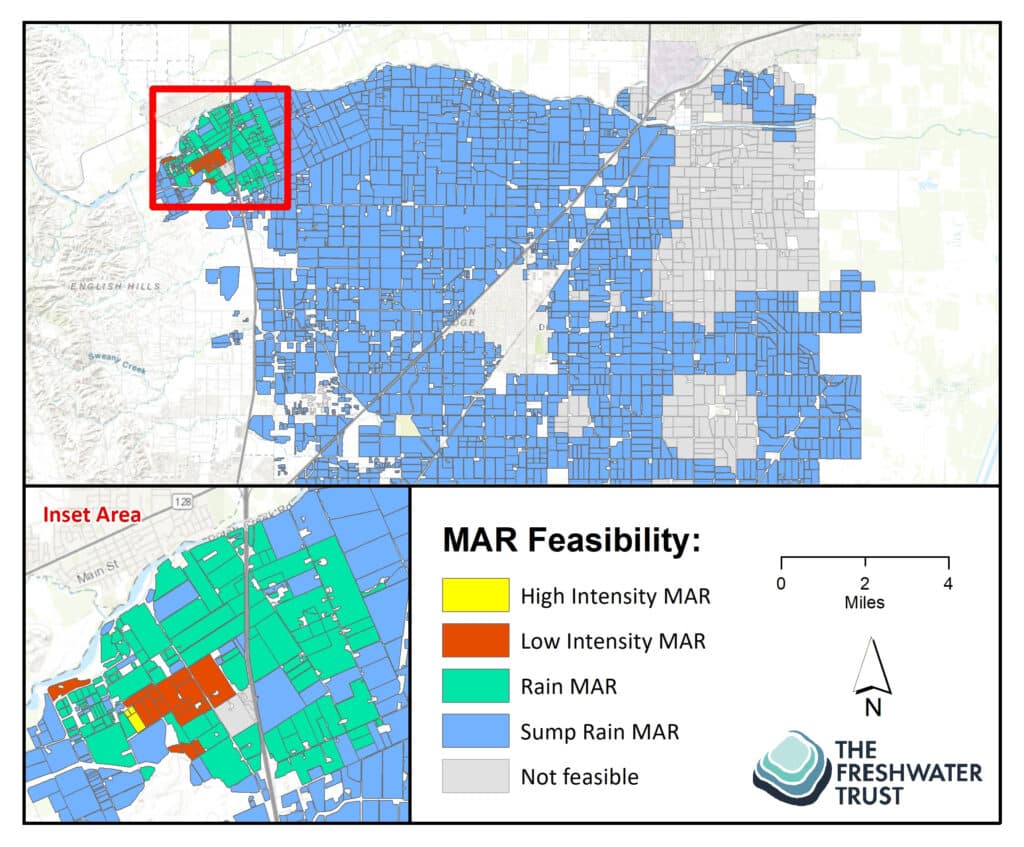Transferable Conservation Methods for Capturing Stormwater to Recharge Groundwater Supplies
April 4, 2023
The Freshwater Trust (TFT) recently completed an assessment of a novel strategy for groundwater recharge in California through funding from the U.S. Department of Agriculture’s Natural Resource Conservation Service (NRCS) Conservation Innovation Grant (CIG) program, with matching funds from local agencies and a State Prop-68 grant.
California’s Central Valley experiences dry and hot summers, a winter rainy season, and wide variability in precipitation. Unpredictable “atmospheric rivers” can dump huge amounts of rain in one to three days. Water resource managers struggle to retain this water before it rushes off the land and out to sea.
To help address this situation, TFT researched cost-effective approaches for retaining stormwater on agricultural fields where there would be no risk of flood or reduced agricultural productivity. The project developed methods for siting and optimizing the benefits and costs of Rainfall Managed Aquifer Recharge (or Rain-MAR).
“In California, we are focused on increasing the sustainability of our stressed and depleted groundwater aquifers,” said Erik Ringelberg, Regional Vice President – California.
“We need effective strategies to recharge groundwater that can be implemented widely at a reasonable cost. Rain-MAR is one promising approach.”
TFT defines Rain-MAR as an aquifer recharge method involving intentional on-farm management actions that result in the purposeful re-use of precipitation that would otherwise run off farm fields. Rain-MAR’s focus on stormwater differentiates it from other types of managed aquifer recharge, such Flood-MAR and Ag-MAR, which focus on the purposeful recharge of applied surface water, such as excess river flows.

“Traditional practices such as Flood-MAR focus on moving and applying excess stormwater from rivers to agricultural fields. With Rain-MAR, we examined methods for keeping rainfall on select fields for recharge,” said Nick Osman, Conservation and Innovation Director. “When we’re talking about groundwater sustainability in California, every bit of water counts.”
While Flood-MAR and Ag-MAR have widespread potential to recharge substantial volumes of surface water, they also require documentation of water rights, water delivery infrastructure, and careful coordination with water suppliers to provide off-season water deliveries.
Rain-MAR, in contrast, provides a simpler method for employing aquifer recharge on farms, thereby encouraging rapid and widespread adoption in appropriate settings. Reducing excess stormwater runoff in flood-prone areas is an added co-benefit.
Capturing rainfall consists of sumps and berms. Sumps are excavated depressions (ditches) adjacent to the lowest elevation edge of a field that capture rain before it runs off the field. Berms are temporary earthen walls along downslope field edges that retain stormwater before it runs off the field.
Both sumps and berms allow the captured water to slowly infiltrate through the soil to the groundwater below.

Benefits of Rain-MAR include:
- Reduced excess runoff to flood-prone areas
- Increased volume and/or rate of groundwater infiltration from precipitation
- Diluted concentration of groundwater contaminants (e.g., salt or nitrates)
- Increased groundwater supply
- Greater water security and resiliency against future droughts and climate change
Applications of the research:
TFT applied its Rain-MAR analyses in several ways, including as a component of a Groundwater Sustainability Plan and as stormwater and flood reduction actions in two counties.
- Sustainable Groundwater Management Plan. TFT developed a demonstration project (a voluntary “project and management action”) for the Solano Subbasin Groundwater Sustainability Plan. TFT worked with the NRCS and the Dixon Resource Conservation District (RCD) to develop preliminary protocols for Rain-MAR practices. TFT also developed prioritization criteria to identify agricultural fields most conducive to Rain-MAR and methods to estimate volumetric benefits and implementation costs. Results show 108 agricultural fields suitable for Rain-MAR within the focus area where the sump or berm methods are feasible. Once the Groundwater Sustainability Agencies secure funding, a demonstration project will be implemented on two or more annual crop fields. See documentation below.
- Stormwater and Flood Reduction. In partnership with Dixon RCD, TFT analyzed the Tremont 3 watershed within the Solano Subbasin to illustrate the potential for stormwater flood reduction by leveraging Rain-MAR in an area with persistent drainage issues. Results show this watershed contains more than 200 fields (9,000+ acres) suitable for Rain-MAR based on soil type and permeability and crop compatibility. Up to 750 acre-feet of stormwater runoff could be avoided depending on the storm events of a given water year. This analysis created comparisons of the cost-effectiveness of Rain-MAR to other stormwater detention strategies (such as expanding or constructing new large detention basins) to alleviate drainage issues in the Dixon area.
- Transferability. TFT assessed the transferability of Rain-MAR methods to new subbasins through an analysis of precipitation, runoff, and groundwater conditions in the Madera Subbasin. TFT’s data visualization system allowed planners and conservation stakeholders to view crop, irrigation, and soil data for each field in the Subbasin to gain insight into areas where Rain-MAR may be suitable. A screening assessment determined whether the volume and frequency of precipitation and runoff were sufficient to warrant an in-depth analysis of Rain-MAR.

Next steps:
TFT will continue to work with the NRCS on recommendations to refine its practice standards for aquifer recharge and incorporate Rain-MAR.
Documentation:
- Rain-MAR Project and Management Action for the Solano Subbasin
- Rain-MAR technical memo for Solano Subbasin
- Stormwater Rain-MAR technical memo for Solano Subbasin
The project titled Stormwater Capture on Agricultural Lands for Groundwater Sustainability was funded by the California Conservation Innovation Grant (CIG) Agreement #NR209104XXXXG007 with matching funds from local agencies and State grants.
#aquifer recharge #California #groundwater #Sustainable Groundwater Management Act
